Sponsored by
We are currently seeking a sponsor for this website
as it follows the progress of the excavations on the battlefield, with contributions from established historians and well known experts, as the team attempt to match the historical evidence and family history to the archaeology on the ground.
If you enjoy this website
please consider making a donation towards the costs of the project.

|
Lost in Flanders Tuesday, January 27th, 2009
|
|
|
|
|
Those of you that followed the project in 2007 will recall the presence of an Australian tv film crew on site. The fruits of their labours will be shown this year (date and time to be announced) and will follow team members Mat and Michael as they look at the discovery of remnants of the Great War in Belgium. Some of this film will examine our excavation and the flyer seems to show two of the dig team on the cover…step forward Jo and Becks…
_
_
Martin and Richard are still liaising with the Australian Govt in attempts to gain an identification of the soldier we found
|
|
|
|
|
|
Filed under: A Dig Diary by
admin
Add a Comment »
|
|
Photographs by Frank Hurley Friday, October 3rd, 2008
|
|
|
|
|
Frank Hurley was the photographer on the Shackleton expedition to the South Pole and then went on to accompany Anzac 3 Div at the Battle of Messines, where he took some remarkable photographs of the battlefield.
_
Hurley felt that his pictures did not capture the full horror of the things he had seen so manipulated images, creating composites of scenes. Some thought this was clearly wrong but others feel it was an appropriate artistic response to the war.
_
An new exhibition at Charleston Farm outside Lewes in Sussex addresses this issue and displays a number of his images.
_
http://www.charleston.org.uk/visit/gallery.html
_
Charleston has its own Great War heritage of a kind in that the Bloomsbury Set holed up there to avoid zeppelin attacks and to be pacifists. Meanwhile the nearby Firle Place was used as a hospital for Australian troops.
_
You can see Hurley pictures on the AWM website:
_
www.awm.gov.au/captured/official/hurley.asp
_
You can also find examples elsewhere on this blog where they are accompanied by photos of the archaeology, landscape and team inspired by Hurley’s work and taken by Ian, our own photographer, who was using a plate camera, just like Hurley’s own.
|
|
|
|
|
|
Filed under: A Dig Diary by
admin
Add a Comment »
|
|
Read All About It Wednesday, October 1st, 2008
|
|
|
|
|
The Plugstreet Project is featured in this month’s “Britain at War” Magazine – available in the UK via WH Smith and Sainsbury’s and all good newsagents.
_
BAW includes a double page spread on the discovery and excavation of the Australian casualty. It includes both text and a number of photographs of the site, the finds and archaeologists at work.
_
www.britain-at-war-magazine.com
_
Thanks to our good friend Mark Khan for the publicity and for his journalistic skill in drafting the story.
_
Britain at War will include a larger piece on the dig in a coming edition. In the meantime this month includes interesting pieces from both World Wars, including a fascinating article on the siege of Tsingtao in 1914, when a combined Anglo-Japanese force assaulted and took the German colony in China. I suspect I’m not alone in never having heard of this action before!
|
|
|
|
|
|
Filed under: A Dig Diary by
admin
Add a Comment »
|
|
Across the site Tuesday, September 9th, 2008
|
|
|
|
|
Although incredibly powerful, the find of the Australian soldier was not the only part of the site this year. The team also worked very hard to accomplish many other elements. Even more of the battle site was subject to geophysical survey and four other trenches were opened. These showed:
_
1) the complete plan of the German bunker seen in part last year
_
2) more of the Lewis gun position on the eastern lip of Ultimo crater
_
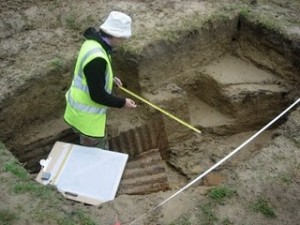
Avril records the Lewis gun post
_
3) a major wriggly-tin-lined redoubt was located on the south edge of Ultimo crater
_
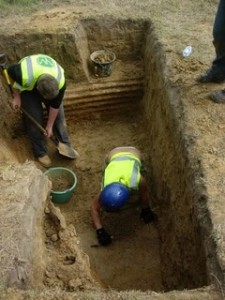
Moving into the redoubt
_
4) at some depth, a massively-engineered timber structure was encountered. Large timbers were found revetted with timber uprights. A gas cape or similar was present here too. Is this a dugout? A German trench mortar position? Something else? Whatever it is, the timbers all appear to have been pushed over in one direction – the blast of the mine?
_
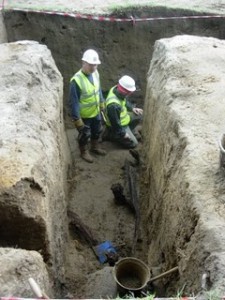
Keith and Jon working with the German feature
|
|
|
|
|
|
Filed under: A Dig Diary by
admin
Add a Comment »
|
|
What they Carried Thursday, September 4th, 2008
|
|
|
|
|
In addition to all the military elements that the Australian soldier had with him, there were some other effects.
_
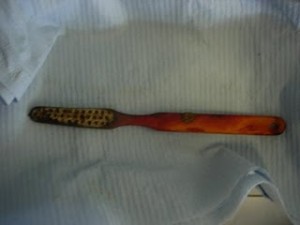
His toothbrush marked – Flexadent France
_
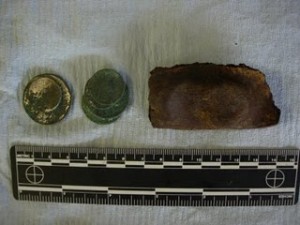
His wallet – some French Francs clearly 1916 dated
_

His spoon (with razor on the top)
_
Finds like these added still more to the overall picture of the man.
|
|
|
|
|
|
Filed under: A Dig Diary by
admin
Add a Comment »
|
|
Dogs in Hats Tuesday, September 2nd, 2008
|
|
|
|
|
This post is more serious than it sounds from the title. I have been considering the pickelhaub we found with the body and in an effort to find out more information about it went here:
www.kaisersbunker.com
_
Yes, there are pictures of dogs in hats and, indeed, helmets on it but it contains lots of lovely information about spiked headgear and the like.
_
Essentially our man had acquired a Hessian helmet. We had wondered if the fluted spike and fishscale chinstrap were indicative of rank and status but it appears that all Hessians had this style, although the scales differed in some cases, with Dragoons apparently having rounded scales.
_
Very useful.
|
|
|
|
|
|
Filed under: A Dig Diary by
admin
Add a Comment »
|
|
DNA testing could reveal WWI Digger’s identit Thursday, August 28th, 2008
|
|
|
|
|
DNA tests could reveal the identity of a World War I Digger whose complete remains have been unearthed by British archeologists at an old battlefield site in Belgium.
_
The remains of the Australian soldier, thought to have been serving with the 3rd Division, were discovered on the site of the Battle of Messines, fought in June 1917.
_
War historian Mat McLachlan said the discovery was unique because the soldier was wearing his full battle kit and appeared to have been buried as a result of an artillery shell exploding nearby.
_
“This is unusual and important because it gives us great insight into the articles actually carried by Australian soldiers into battle,” Mr McLachlan told The Australian yesterday.
_
Mr McLachlan, a member of the archeological group No Man’s Land, said the soldier was found with his hand still grasping his standard-issue Lee Enfield rifle, which had the bayonet attached.
_
“It really is a snapshot of an Aussie soldier because he was killed, fell to the ground and covered with dirt and that was the last anyone saw of him until 90 years later when these guys dug him up,” he said.
_
Defence Minister Warren Snowdon said the Digger’s remains were held by the Belgian army and it was hoped that DNA tests could reveal his identity. It is likely his remains will be interred at one of the Commonwealth War Graves cemeteries in Belgium later this year.
_
Mark Dodd
The Australian
|
|
|
|
|
|
Filed under: A Dig Diary by
admin
Add a Comment »
|
|
A couple more images Friday, August 22nd, 2008
|
|
|
|
|
We shall aim to post some images of the other main excavation trenches at Plugstreet 2008 at some point over the weekend, but in the meantime, a couple more images of items found with the Australian.
_
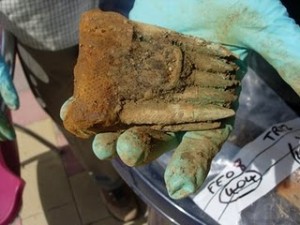
An image of one of the pockets of ammunition with chargers of .303 rounds and webbing attached to the pocket.
_
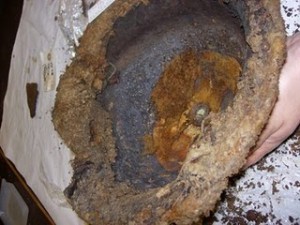
This is the interior of the brodie helmet note the buckles of the straps at the edge – with the mineralised strap thus up over the outer rim of the helmet
_
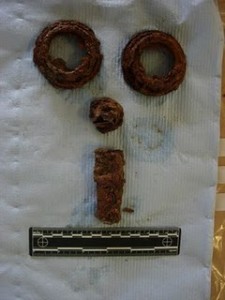
The components of the PH hood following initial conservation work
_
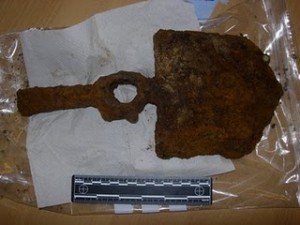
The entrenchment tool found at the back of the man, below his pack
_
|
|
|
|
|
|
Filed under: A Dig Diary by
admin
Add a Comment »
|
|
Some of the finds Wednesday, August 20th, 2008
|
|
|
|
|
In the following days we will aim to post some of the images from other important parts of the excavations of 2008. Today perhaps it would be worthwhile to show some of the finds with the man that was excavated
_
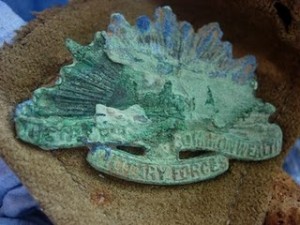 _
_
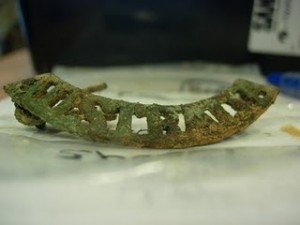
Proof of nationality (Collar badge and shoulder title)
_
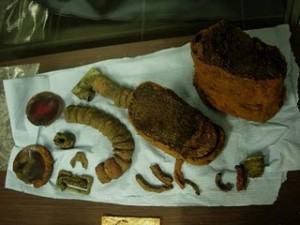
_

Box respirator and iodine under conservation
_
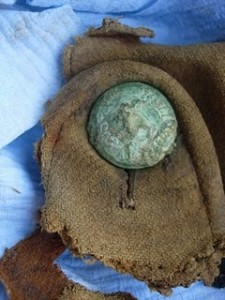
_
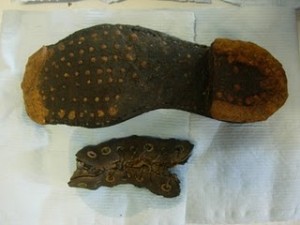
Button and Boot
_
We have posted these images as only a TINY portion of the kit found with the man to illustrate the quality of the surviving elements. Other parts of his panoply of arms are as well preserved and his remains too tell a story. We shall post more over the coming weeks
|
|
|
|
|
|
Filed under: A Dig Diary by
admin
2 Comments »
|
|
Ministerial Announcement in Australia Wednesday, August 20th, 2008
|
|
|
|
|
THE HON. WARREN SNOWDON MP Minister for Defence Science and Personnel
_
MISSING WORLD WAR ONE SOLDIER DISCOVERED IN BELGIUM
_
The Minister for Defence Science and Personnel, the Hon. Warren Snowdon MP, today announced the remains of an unidentified Australian World War I soldier have been unearthed in Belgium.
_
The human remains were discovered along with pieces of Australian equipment and clothing during an authorised excavation by a British archaeology team at Ploegsteert; the site where the Battle of Messines took place in June 1917.“I can confirm the remains of one of our courageous World War I soldiers have been uncovered in Belgium,” Mr Snowdon said.“Two British archaeologists undertaking an official excavation unearthed the remains, along with evidence they are of a fallen Australian Digger who fought in the Battle of Messines.”
_
The bones, which are reported to be in reasonably good condition, were exhumed under the supervision of the Belgian Police and Army, who are housing the remains at a Belgian Army Barracks until further notice from Australian authorities.
_
“The Australian Government is firm in our commitment to honour our war dead, and is already undertaking historical research to establish any initial identification links,” Mr Snowdon said.“We are also hopeful that some of the equipment located with the remains, such as badges and buttons, may assist with identification of the soldier and will consider the possibility of DNA testing if there is reasonable chance of a match.”
_
It is likely the remains will be re-interred at one of the existing Commonwealth War Graves Cemetery in Belgium later this year.
|
|
|
|
|
|
Filed under: A Dig Diary by
admin
Add a Comment »
|
|
|
|
|
|